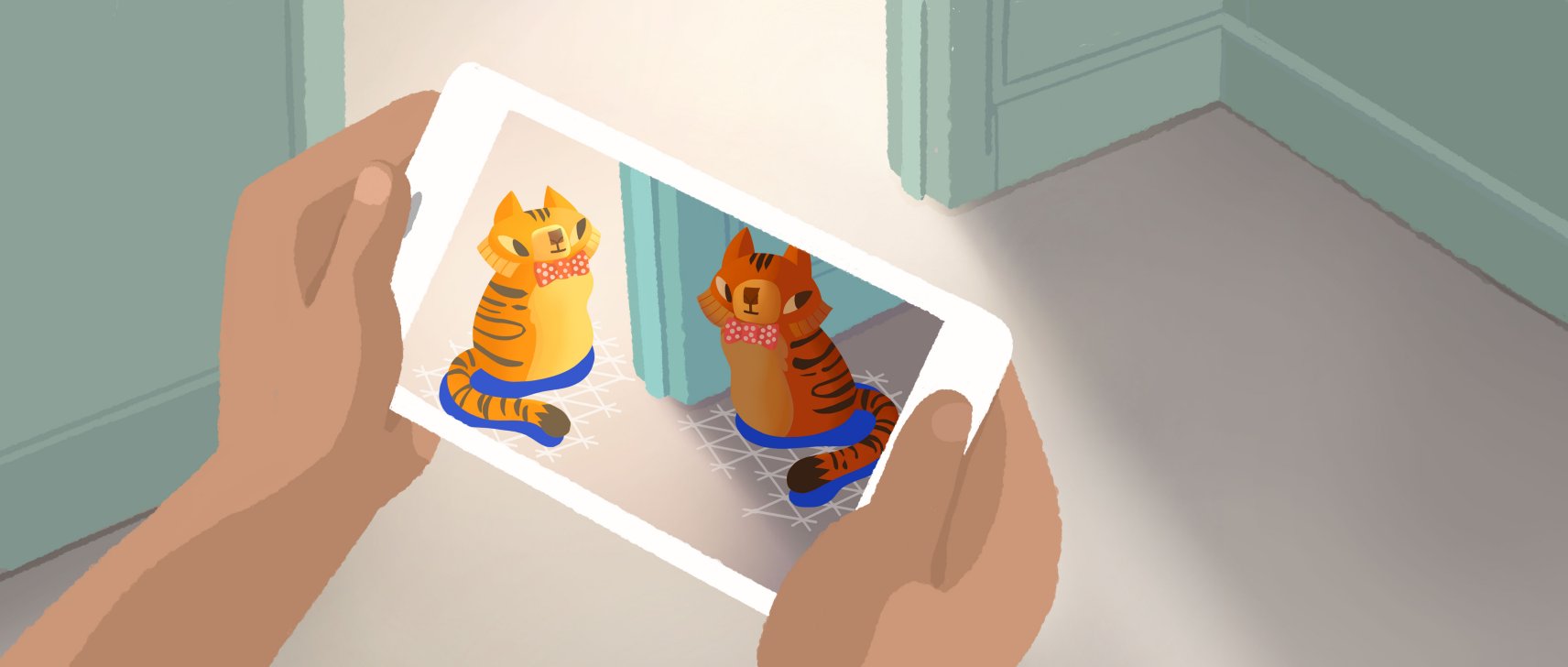Google于8月份正式推出了ARCore,ARCore的介绍可以参见官网。作为ARKit的竞赛对手,ARCore有一个致命的缺点,就是支持的机型较少,目前只支持Google的Pixel和三星S8手机。不过刚好有一个Pixel手机。于是想要开发一个ARCore的应用,后来有了一个想法就是ARCore和人脸结合的Demo。
一、ARCore的基础概念
根据官网上的介绍,ARCore的核心功能是:
Motion tracking:allows the phone to understand and track its position relative to the world.
Environmental understanding: allows the phone to detect the size and location of flat horizontal surfaces like the ground or a coffee table.
Light estimation :allows the phone to estimate the environment’s current lighting conditions.
Environmental understanding功能如下所示

Light estimation 的效果如下所示

二、接入人脸识别
由于检测人脸的代码是之前项目中写的,所以使用Unity来实现不太好实现,所以选用Android对应的SDK。SDK地址:https://github.com/google-ar/arcore-android-sdk
首先看一下Demo中如何使用OpenGL实时渲染Camera数据的,整个流程位于BackgroundRenderer.class
/**
* This class renders the AR background from camera feed. It creates and hosts the texture
* given to ARCore to be filled with the camera image.
*/
public class BackgroundRenderer {
//可以看到这个定义了textureId,所以是通过surfaceTexture对摄像头的数据进行了处理
private int mTextureId = -1;
public void setTextureId(int textureId) {
mTextureId = textureId;
}
public void createOnGlThread(Context context) {
// Generate the background texture.
int textures[] = new int[1];
GLES20.glGenTextures(1, textures, 0);
mTextureId = textures[0];
//可以看到我们在这里生成了一个textureId。然后绑定纹理对象ID。
GLES20.glBindTexture(mTextureTarget, mTextureId);
...
}
public void draw(Frame frame) {
// If display rotation changed (also includes view size change), we need to re-query the uv
// coordinates for the screen rect, as they may have changed as well.
//这两行很重要,用来更新视图矩阵
if (frame.isDisplayRotationChanged()) {
frame.transformDisplayUvCoords(mQuadTexCoord, mQuadTexCoordTransformed);
}
// No need to test or write depth, the screen quad has arbitrary depth, and is expected
// to be drawn first.
GLES20.glDisable(GLES20.GL_DEPTH_TEST);
//禁止向深度缓冲区写入数据
GLES20.glDepthMask(false);
GLES20.glBindTexture(GLES11Ext.GL_TEXTURE_EXTERNAL_OES, mTextureId);
// Restore the depth state for further drawing.





 本文介绍了将Google ARCore与人脸识别技术相结合的实践过程。首先概述了ARCore的基础概念,包括运动跟踪、环境理解及光线估计。接着讲述了如何在Android环境下接入人脸识别SDK,并通过OpenGL获取并处理摄像头数据。在实现过程中遇到的图像横屏、上下翻转等问题也进行了讨论。最后,文章展示了如何加载带mtl的obj格式3D模型,并分享了在fbx模型转换和加载中遇到的挑战。
本文介绍了将Google ARCore与人脸识别技术相结合的实践过程。首先概述了ARCore的基础概念,包括运动跟踪、环境理解及光线估计。接着讲述了如何在Android环境下接入人脸识别SDK,并通过OpenGL获取并处理摄像头数据。在实现过程中遇到的图像横屏、上下翻转等问题也进行了讨论。最后,文章展示了如何加载带mtl的obj格式3D模型,并分享了在fbx模型转换和加载中遇到的挑战。
 最低0.47元/天 解锁文章
最低0.47元/天 解锁文章
















 764
764

 被折叠的 条评论
为什么被折叠?
被折叠的 条评论
为什么被折叠?








